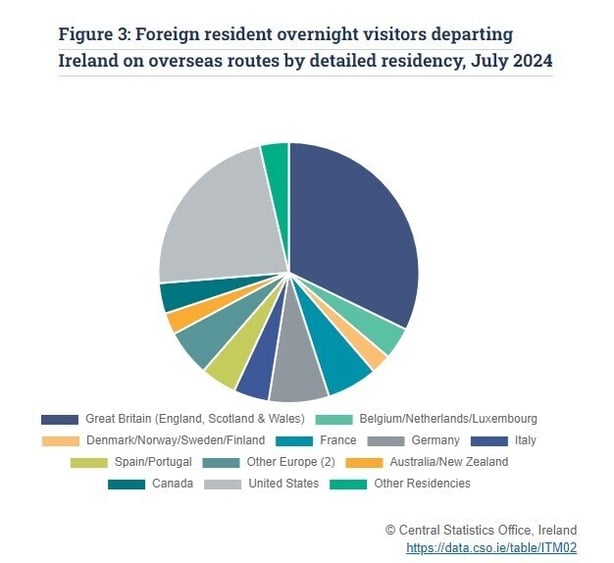The number of visitors to Ireland during the key tourist month of July was almost flat compared to the same month last year.
According to data released today by the Central Statistics Office, 655,400 foreign visitors came to Ireland during July, up just 0.8% on a year earlier.
However, the figure was down compared to the previous month of June when 669,500 people visited the country.
Almost a third of the tourists this July came from Great Britain, with the next biggest cohort of 23% coming from the US, followed by almost 8% from Germany.
But while the number of visitors was up slightly, the total number of nights of stay was down on a year earlier, with 5.3m nights recorded during the month, 6.2% lower than July of 2023.
The average length of stay was 8.1, which is reduction of 0.6 nights compared to the same month a year ago.
Spend was up by 5% year on year to €919.2m however, with higher prices driven by the higher cost of living and increase VAT rate likely to have been a significant cause.

Four out of every ten visitors stayed in hotels during their stay, with 36% staying with family or friends or in their own property.
On average each visitor spent €1,403 on their trip, up from €1,346 12 months previously.
€411 went towards fares, €48 on prepayments, €430 on accommodation and €514 on day to day spending.
Of the 655,400 foreign visitors in July, 46% came for a holiday or leisure, with 30% here to see family or friends and 13% visiting on business.
The number of Irish residents travelling overseas in July was 1.363m, up from 1.278m in the same month last year and 1.278m in June.
Michael Magner, owner of the Vienna Woods Hotel in Cork, said the summer has been steady when it comes to occupancy, but that there has been a change in the visitor type coming to the hotel.
"Overseas visitors have certainly stayed steady," said the hotelier, who is the current president of the Irish Hotels Federation.
"However, the domestic market is back right across the industry, and that is due in no small par tto the significant costs out there."
"We've seen in our own business that significant operating costs are particularly challenging. We saw an increase of VAT of 50% last September and ongoing business costs are particularly challenging."
"And that means that the domestic market, the local consumer, has less money in their pocket because costs have gone up right across the country. And that presents a challenging dynamic, particularly in food related areas."
He added that Government action on the VAT rate is needed to ensure sustainability of the sector into the future.
Mr Magner said he would reject suggestions that hotel prices in Ireland are high, adding that there is great value to be had.
He said Government commissioned research published last year had confirmed this.
He added that the weather this summer has not helped, particularly for those who have outdoor elements to their business.
Paul Kelly, chief executive of Failte Ireland, said it had been a mixed season and overall it is likely to be down a bit on last year.
He said that was the result of a combination of overseas visitors being up but the length of stay being slightly down and domestic tourism being down too.
"We think that might be driven by things like the Olympics being in European and maybe a lot of people may have gone across to the Olympics and of course the weather particularly in the early summer when the weather was poor lots of people made plans to go overseas to chase the sun," he said.
Mr Kelly said everybody in the sector was finding it difficult to turn increases in the top line into bottom line profitability because of the rising cost base.
But he said despite some perceptions, Ireland is not out of line internationally when it comes to the cost of tourism for visitors.
"We're not seeing any significant feedback from overseas visitors saying that Ireland is poor value. In fact for US visitors they find Europe in general very good value and find Ireland good value as well," he said.
The CEO of the body that runs the Dunbrody Famine Ship experience said it had experienced a "tough July".
Sean Connick, chief executive of the John F Kennedy Trust that operates the tourist attraction, said certain markets, including the UK, France and Germany remain soft.
"We need them back, I know the tour companies were saying that July and August were quite soft as well," he said.
He said visitor numbers remain well below pre-Covid levels and the issue of Ireland being perceived by some as a high-cost destination needs to be addressed.
Mr Connick was speaking as an enhanced visitor experience was launched at the Dunbrody Famine Ship, following a €1.6m investment from the Department of Rural and Community Development, Fáilte Ireland, and Wexford County Council.
The upgraded experience tells the famine emigrant story, centred on a reproduction of an 1840s vessel that set sail for America during the Great Famine.
The new immersive visitor experience uses a mix of digital interpretation and archive material, such as personal letters and records from the time, to bring to life one of the most pivotal events in Irish history and help visitors to connect with the human stories of those who journeyed across the Atlantic.
Fáilte Ireland has estimated that over a ten-year period, the Dunbrody Famine Ship experience has the potential to attract over 211,000 additional local, domestic and overseas visitors, generating over €9m in visitor expenditure for the local economy and supporting 36 jobs.







